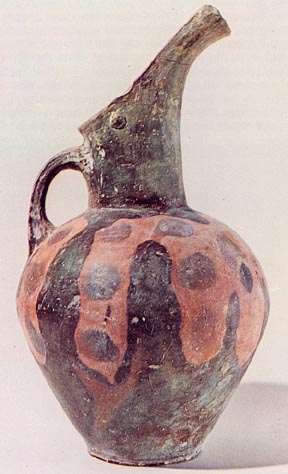The Early Bronze Age
c. 3000-2000 BCE
EARLY MINOAN POTTERY
"VASILIKE WARE"
In the Second Phase of Early Minoan pottery (c. 2500-2200 BCE - EMII) appears a type of pottery known as "Vasilike ware" after a place in East Crete where it was first found in abundance. The decorative system is dark-on-light with the paint applied over the entire surface but leaving a mottled black, red, and brown surface with large dark areas. It appears to be imitating earlier variegated stone vases. It is thick-walled, sturdy, extremely well made, and beautifully finished. The shapes range from conservative to highly exotic. Most typical are a teapot shape with an exaggerated spout, and a jug with a high spout.
The mottled decoration is the most distinctive and easily recognizable feature. The surface is always covered with a slip, burnished and fired so that it varies from red to brown to black, Many vases have pale areas with several black patches. See Philip Betancourt, 1985

Vasilke-style beaked jug
from Vasiliki
c. 2500-2400 BCE
(Archaeological Museum, Herakleion, Crete)
One of the most popular shapes is a type of beak-spouted jug with raised clay pellet forming an "eye". This shape occurs later in the Middle Minoan period in KAMARES WARE
|
|
|
|

 SPRING 2016
SPRING 2016  SCHEDULE
SCHEDULE  REQUIREMENTS
REQUIREMENTS

 SPRING 2016
SPRING 2016  SCHEDULE
SCHEDULE  REQUIREMENTS
REQUIREMENTS